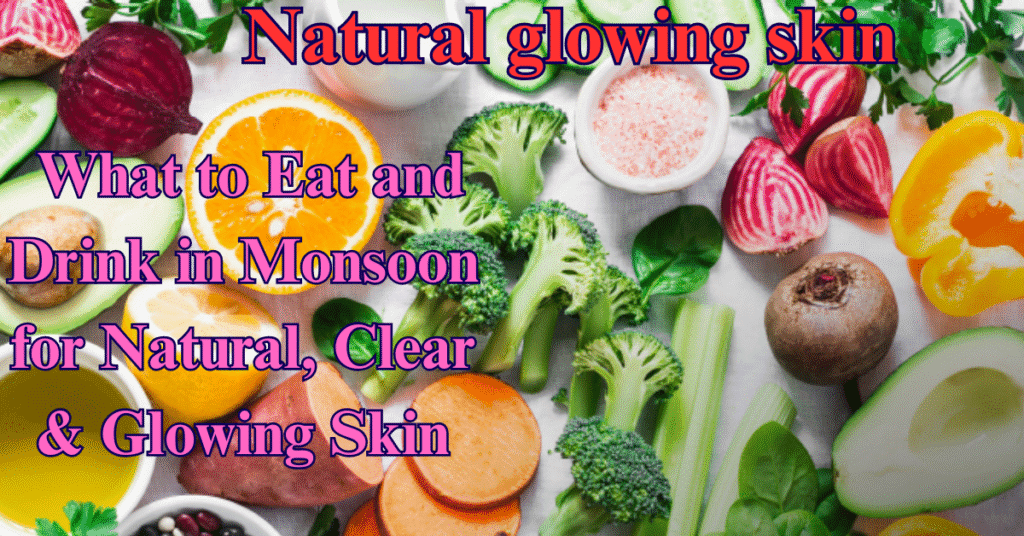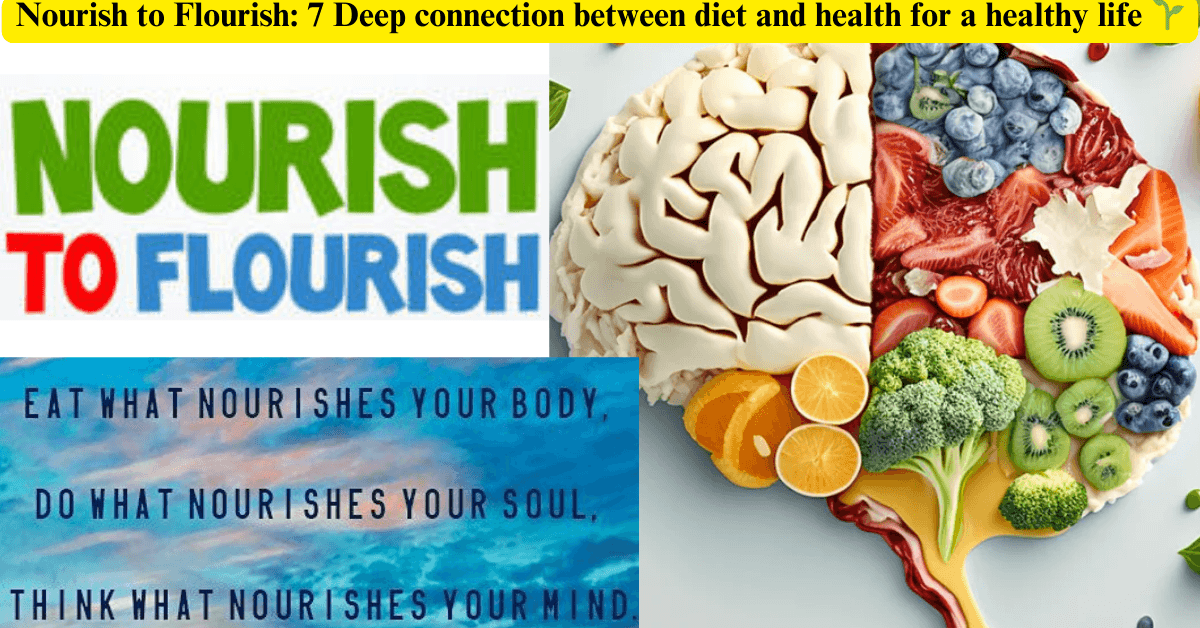
Table of Contents
🌼 Natural glowing skin
Natural glowing skin : The monsoon is a time of rejuvenation for nature—but for our skin, it often brings dampness, excess oil, clogged pores, and breakouts. Increased humidity leads to sweat and grime buildup, which can make the skin dull, oily, or acne-prone. But the secret to glowing skin during monsoon lies in what you eat and drink.
A clean, seasonal, and immune-boosting diet can help detox the body, improve digestion, and reduce skin inflammation. Here’s your ultimate monsoon diet guide—including skin-friendly teas, fruits, hydration tips, and food habits.
Natural glowing skin
☕ Herbal Teas: Heal from Within
Herbal teas help tackle the root causes of skin problems during the monsoon—like poor digestion, low immunity, and blood impurities. Drinking the right herbal infusion daily can support clear, glowing skin.
🌿 1. Tulsi-Ginger-Chamomile-Cinnamon Tea
These herbs work synergistically to:
- Purify blood (reducing acne and pigmentation)
- Reduce inflammation and skin redness
- Improve circulation, delivering nutrients to skin tissues
- Calm the nervous system, promoting sound sleep—a critical factor for skin repair
🌟 Tip: Drink this tea 30 minutes after lunch or in the evening.
🟡 2. Lakadong Turmeric Ginger Tea
How to prepare:
- Boil 1 cup of water with 1 tsp grated ginger.
- Add ¼ tsp Lakadong turmeric (known for highest curcumin content in India).
- Add ½ tsp lemon juice and drink warm.
Why it works:
- Curcumin fights skin-damaging free radicals.
- Ginger improves digestion, reduces bloating and supports detox.
- Warmth helps balance Vata and Kapha doshas, which are often aggravated in monsoons (per Ayurveda).
🌿 3. Gotu Kola + Manuka Honey Tea
Preparation:
- Steep 10 fresh gotu kola leaves in hot water for 20 mins.
- Strain and stir in 1 tsp Manuka honey (not regular honey).
Benefits:
- Gotu kola is rich in compounds that stimulate collagen production, smoothen skin texture, and speed up wound healing.
- Manuka honey has antimicrobial activity due to methylglyoxal (MGO), which supports gut health, skin immunity, and sore throat relief.
📌 Drink 3–4 times per week for visible skin improvements.
🍎 Fruits to Eat in Monsoon for Skin Nourishment
Seasonal fruits hydrate, alkalize the body, and provide vital vitamins for skin repair.
🍈 1. Bael (Wood Apple): The Digestive Cleanser
- High in vitamin C, fiber, tannins, and antioxidants
- Promotes gut detox, a key to preventing acne
- Anti-parasitic and anti-inflammatory, ideal for rainy season digestion
💡 Have it as a pulp, smoothie, or bael sherbet in the morning on an empty stomach.
🫐 2. Phalsa (Indian Summer Berry): Antioxidant Powerhouse
- Contains anthocyanins, vitamin C, calcium, and iron
- Acts as a natural astringent: tightens pores and regulates oil
- Improves liver function → better skin detox and pH balance
🥤 Best consumed as a freshly pressed juice or snack between meals.
💧 How to Stay Hydrated Right in Monsoon
Hydration isn’t just about drinking water—it’s about retaining the right balance of fluids, electrolytes, and nutrients. Too much water can dilute electrolytes, while too little leads to dryness and dullness.
✔ Smart Hydration Tips:
- Start your day with warm water + lemon + honey
- Sip fennel or coriander water after meals
- Drink buttermilk with rock salt mid-afternoon
- Avoid carbonated drinks, chilled water, and excessive caffeine
🍽️ Monsoon Diet Rules for Healthy Skin
A wrong diet in this season can cause bloating, gas, rashes, or even fungal infections. Stick to light, warming, and home-cooked meals that aid digestion and immunity.
✅ What to Include:
- Soups with turmeric, garlic, and pepper
- Steamed veggies like bottle gourd, zucchini, pumpkin
- Mung dal khichdi with ghee and cumin
- Fermented foods like idli, dosa (in moderation)
- Probiotics: fresh curd, chaas (not too cold)
- Ghee (clarified butter): supports gut lining and skin hydration
❌ What to Avoid:
- Fried snacks (pakoras, samosas) → clog pores
- Leafy greens (can carry water-borne bacteria)
- Ice creams, desserts → cause inflammation and sugar spikes
- Processed, preserved foods
- Non-veg food in excess (especially from outside)
🧴 Common Monsoon Skin Issues and Their Dietary Solutions
| Skin Issue | Cause | Dietary Remedy |
|---|---|---|
| Pimples/Breakouts | Poor gut health, high oil intake | Ginger tea, bael fruit, probiotics |
| Dull Skin | Lack of nutrients & water retention | Phalsa, turmeric tea, citrus fruits |
| Fungal Infections | Humidity, excess sugar | Avoid sweets, take tulsi & cinnamon |
| Excess Oiliness | Fried food, poor digestion | Eat steamed food, add astringent fruits |
| Uneven Tone | Blood toxicity | Herbal detox teas, vitamin C fruits |
🌿 Daily Routine for Glowing Skin in Monsoon (Diet-Based)
| Time | Routine |
|---|---|
| 7:00 AM | Warm lemon water with honey |
| 8:30 AM | Breakfast: Oats with banana or poha + herbal tea |
| 11:00 AM | Bael fruit or phalsa juice |
| 1:00 PM | Lunch: Rice + moong dal + bottle gourd sabzi + chaas |
| 4:00 PM | Gotu kola + Manuka honey tea |
| 6:00 PM | Roasted makhana or fruit bowl |
| 8:00 PM | Dinner: Light khichdi or soup with turmeric |
| 9:30 PM | Chamomile tea for skin repair during sleep |
🧘 Bonus Tip: Mind-Body Connection
Stress is a major contributor to skin issues. Combine your diet with:
- 30 minutes of yoga or walking
- Deep breathing (pranayama)
- Adequate sleep (7–8 hrs)
MonsoonDiet, #GlowingSkinTips, #HealthySkin, #RainySeasonCare, #SkincareFromWithin, #HerbalTeas, #LakadongTurmeric, #GotuKolaBenefits, #PhalsaFruit, #BaelFruit, #NaturalSkincare, #SkinDetox, #MonsoonBeauty, #SeasonalFruits, #MonsoonWellness, #AyurvedicDiet, #ClearSkinNaturally, #HydrationTips, #ImmuneBoostingFoods, #SkincareRoutine
✅ Conclusion
Monsoon skin care is not just about what you apply on your skin, but more about what you feed your body. A diet rich in seasonal fruits, detoxifying teas, probiotic foods, and antioxidants can help you maintain radiant skin even in the most humid and infection-prone season.
By making smart food and drink choices, supporting digestion, and reducing inflammation, you can embrace the rainy season with a natural glow from within.


